Understanding Age-Related Macular Degeneration
The macula consists of millions of light-sensing cells which provide sharp, central vision.
The Macula is the most sensitive part of the retina and is located at the back of the eye. The retina turns light into electrical signals and then sends these electrical signals through the optic nerve and then it reaches the brain. Here they are translated into images that we see.

So What is Age- Related Macular Degeneration?
Age-related Macular Degeneration (AMD) is a common eye condition and one of the leading cause of vision loss among people age 50 and older.
AMD is caused by damage to the macula, and can result in blurred, dark and distorted vision.
In some people, AMD advances slowly so vision loss does not occur for a long time.
In other people, the disease can cause damage way faster and vision loss in one or both eyes, is likely to occur.
Am I at Risk for AMD?
Age plays a very big role in age-related Macular Degeneration.
The disease is more likely to occur after the age of 60.
Other risk factors include:
- Smoking- Research has proven that smoking can double the risk for this disease.
- Race- It is more common in Caucasians then in African Americans or Hispanic/Latinos.
- Family History- People with a family history are at much higher risk.
- Obesity- Severely overweight individuals have an increased risk of developing AMD.
If you or a loved one is experiencing signs of macular degeneration, it is recommended that you have a complete eye exam as soon as possible, to minimize loss of vision.
Glaucoma Symptoms
Glaucoma refers to a group of eye disorders that can all cause damage to the optic nerve that carries information from the eye to the brain.
Glaucoma usually has few or no initial symptoms. This is why eye checkups should be scheduled regularly.
In the majority of cases, glaucoma is associated with having higher-than-normal pressure inside the eye. But it can also occur when intraocular pressure (IOP) is normal.
If it goes untreated or uncontrolled, glaucoma can cause peripheral vision loss and can even lead to blindness.
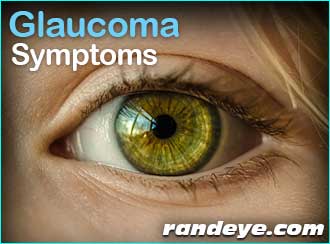
Types of Glaucoma and Symptoms
Primary open-angle glaucoma.
- This common type of glaucoma gradually reduces your peripheral vision without other symptoms. By the time you notice it, permanent damage already has occurred.
- If your IOP remains high, the loss of your vision can progress until tunnel vision, and you will be able to see only objects that are straight ahead.
- Ultimately, all vision can be lost, leading to blindness.
Acute angle-closure glaucoma.
- This is also called narrow-angle glaucoma.
- This type of glaucoma produces sudden symptoms such as eye pain, headaches, halos around lights, dilated pupils, vision loss, red eyes nausea and vomiting.
Normal-tension glaucoma.
- Normal-tension glaucoma is a type of open-angle glaucoma that can cause visual field loss due to optic nerve damage.
- In normal-tension glaucoma, the eye’s IOP remains in the normal range.
- Pain is unlikely and permanent damage to the eye’s optic nerve will most likely not be noticed until symptoms such as tunnel vision occur.
- The cause of normal-tension glaucoma is still not known. Many doctors believe it is related to poor blood flow to the optic nerve.
- Normal-tension glaucoma is more common in those who are Japanese, are female and/or have a history of vascular disease.
Congenital glaucoma.
- This is an inherited form of glaucoma, and is present at birth, with 80 percent of cases diagnosed by age one.
- Children diagnosed with this type of Glaucoma are born with narrow angles or another type of defect in the drainage system of the eye.
- It’s hard to spot the signs of congenital glaucoma, because children most likely do not understand what is happening to them or notice the changes in vision.
- If you notice a cloudy, white, hazy, enlarged or protruding eye in your child, talk to your eye doctor.
Glaucoma Treatment Options
In general glaucoma cannot be completely cured, but it can be controlled.
Most treatments for glaucoma are designed to reduce or control the intraocular pressure (IOP), which can damage the optic nerve that transmits visual information to the brain.
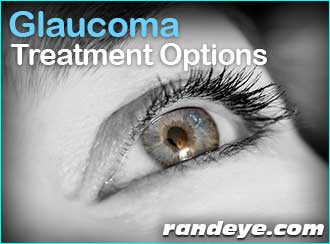
Treatment for glaucoma depends on the severity of each case.
Glaucoma Treatments:
Medicine
Glaucoma is often treated with eye drops that are taken several times each day.
The eye drops help the way the eye fluid circulates as well as lowers eye pressure, by decreasing the production of fluid within the eye or by increasing the flow leaving the drainage angle.
Glaucoma can worsen over time without you even being aware, so your treatment will likely change in order to help achieve a lower eye pressure.
Laser Surgery
Laser surgery is also effective for glaucoma treatment. There are two main types:
- Trabeculoplasty is a type of laser treatment that enhances eye drainage function and helps control eye pressure within the eye when treating open-angle glaucoma.
- Iridotomy is a laser treatment that makes tiny holes in the iris to help improve the flow of eye fluid to the drain when treating narrow angle.
Operative Surgery
If both the eye drops and laser therapy treatment have not been successful in lowering the eye pressure, your doctor might suggest an operative surgery to be performed.
With this surgery a new bypass drainage tunnel will be created using a microscope and specialized instruments, to help the eye fluid to leave the eye.
Each case of glaucoma is different and treated differently. Talking to your doctor can help you distinguish which treatment is best for you.
With any type of glaucoma, regular eye examinations are very important.
Glaucoma Disease Risk Factors
Glaucoma is a disease that causes damage to the eye’s optic nerve.
The optic nerve, which is connected to the retina and is made up of many nerve fibers, is responsible for sending signals from your retina to your brain. These signals are interpreted as the images you see.
In a healthy eye, a clear fluid called aqueous humor circulates the front portion of your eye.
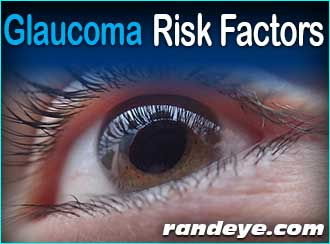
To maintain a constant healthy eye pressure, your eye continually produces a small amount of aqueous humor while an equal amount of this fluid flows out and leaves your eye.
If you have glaucoma, the aqueous humor does not flow out of the eye in the way that it should. Fluid pressure in the eye builds up and, over time, causes damage to the optic nerve fibers.
If left untreated, Glaucoma can lead to vision loss and eventually can even lead to blindness.
Here are some of the factors that may put you at risk for Glaucoma…
Age-
- People over 60 are at increased risk for the disease.
- The risk of developing glaucoma actually increases with every year of age.
- African Americans have an increase risk beginning at the age of 40.
Ethnic Background-
- African-Americans older than age 40 have much higher risk of developing glaucoma than do Caucasians.
- African-Americans also are more likely to experience permanent blindness as a result of glaucoma.
- People of Asian descent have an increased risk of developing acute angle-closure glaucoma.
- People of Japanese descent may be more likely to have normal-tension glaucoma.
Family history of glaucoma-
- If you have a family history of glaucoma, you have a greater risk of developing it.
- Glaucoma may have a genetic link, meaning there’s a defect in one or more genes that may cause certain individuals to be more susceptible to the disease.
- A form of juvenile open-angle glaucoma has been clearly linked to genetic abnormalities.
Medical conditions-
- Several conditions may increase your risk of developing glaucoma, including diabetes, heart diseases, high blood pressure and hypothyroidism.
- Previous eye injuries can also build up to Glaucoma.
It is recommended that you get regular eye exams. Early detection and treatment is the best way to minimize the risks of Glaucoma.
Holiday Season Eye Safety Tips
This holiday season eye safety may not be your foremost concern. However, this time of year can be dangerous for your eyes due to toys, sports and other potential hazards. Here’s how you can protect your precious sight during the holidays. 
Christmas Tree Tips:
Who would think the eye-catcher and focal point of the season, the Christmas tree, could be the very thing to cause you injury? Christmas tree injuries are very common, and should be addressed.
- Wear eye-protective wear when cutting your tree.
- Hang glass ornaments out of reach for small children.
- Do not put gifts too far under the tree for small children.
- Be careful around the tree, especially when reaching for gifts to not be hit in the eye with a branch.
Toy Tips for Parents:
Children are so excited to open their gifts and play; the last thing on their mind is eye safety. Unfortunately, toy-related eye injuries are at an all time high in the holiday season according to the Consumer Product Safety Commission. Most of the injuries are preventable.
- Supervise children with new toys they may not be used to operating.
- Avoid buying toys with sharp edges or projectile parts.
- Choose toys based on child’s age but most importantly, their maturity level.
- Explain proper use of toys to children before allowing them to find out alone.
Ready to Pop Champagne and Celebrate:
Social gathering, spreading the holiday cheer sounds like the ultimate plan. Adults, when ready to pop the champagne remember to be careful. No one wants to be hit in the eye with the cork.
- Remember to hold the cork down firmly with the palm of your hand while removing the wire.
- Use a towel and point it away from yourself and others.
- Keep the bottle at a 45-degree angle.
- Hold the cork down with the palm of your hand while you remove the wire hood.
Snow Glare while Driving:
Although, our Floridian patients do not need to worry about this, if you are traveling and driving in the snow always be cautious.
It is a misconception that sunglasses are only needed in the summer.
- Wear sunglasses with polarized lenses
- Keep windshield clean for smudges and particles that can distract clear vision on the road.
The holiday season is a joyous time of friends, family and food. Lets keep it that way by paying close attention to these eye-safety tips.
LASIK Commercial – Rand Eye Institute
LASIK Eye Surgery TV Commercial for Rand Eye Institute’s 2016 LASIK promo. The No-Flap LASIK procedure is a great option to free yourself from glasses.
To learn more, please visit our LASIK page: http://www.randeye.com/lasik/
Rand Eye Foundation Charity Event
Rand Eye Foundation Charity Event. Thanks to all who attended, and supported the Rand Eye Foundation! Dedicated to the Prevention of Blindness.
Preventing Toy Related Eye Injuries
The holiday season is finally here! 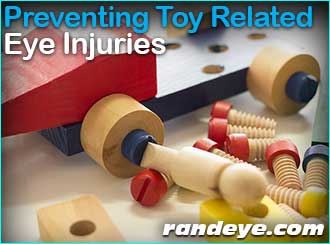
As we gather with friends, family and loved ones it is important that we factor in their safety to help promise a safe, happy time.
No one chooses gifts with the intent to cause harm, but what many people do not realize when purchasing some popular children’s toys, is that is what can happen.
Each holiday season, toys and sporting equipment, that were meant to bring joy, are actually responsible for thousands of eye injuries to children?
But do not let that ruin the holiday spirit. These eye injuries are totally preventable!
Parents can keep their children safe by demonstrating the proper use of toys, purchasing age-appropriate toys and supervising them while in use.
Safe Toy Checklist:
- Read all warnings and instructions.
- Make certain children wear appropriate eye protection for sports (face shields, helmets).
- Avoid toys with sharp or rigid points, spikes, or projectile-firing parts.
- Inspect toys for safe, sturdy construction. Toys should be durable and able to withstand impact.
- Look for the letters “ASTM” which means the toys met the national safety standards set by the American Society for Testing and Materials.
- Repair or replace damaged or defective toys.
- Try not to purchase flying toys. Bows, arrows, slingshots, and darts can be extremely dangerous.
- Check for age labels on the toys and be sure to choose toys that are appropriate for a child’s age and maturity.
- Do not give toys with small parts to young children. They tend to put them in their mouths, increasing the risk of choking.
Happy Thanksgiving – 2015
The Rand Eye Institute wants to wish you all a blessed Thanksgiving Day filled with love, joy and happiness.
We would like to take this opportunity to Thank You! for choosing the Rand Eye Institute, for all your eye care needs.
Have a Safe and HAPPY THANKSGIVING!
Diabetes Can Cause Vision Problems
People who do have diabetes have a higher risk for blindness than people without it.
Some of these vision problems include: 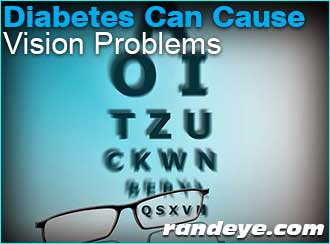
Glaucoma
People with diabetes are 40% more likely to suffer from glaucoma than people without it. The longer someone has diabetes, the more common it is. Risk also increases with age.
Cataracts
Many people without diabetes get cataracts, but people with it are 60% more likely to develop them. People with diabetes also tend to get cataracts at a much younger age and have them progress faster. With cataracts the eyes clear lens cloud up and block light.
Retinopathy
Diabetic retinopathy is a term used for all disorders caused by diabetes. There are two major types of retinopathy: non-proliferative and proliferated.
Non-proliferative Retinopathy: Is the most common type of retinopathy. This occurs when capillaries in the back of the eye balloon up and form pouches. Non-proliferated retinopathy can move through three stages (mild, moderate and severe) as more blood vessels become blocked.
Proliferative: In this form, the blood vessels are so damaged they close off and new vessels start growing in the retina. These new vessels are very weak and can leak blood, blocking vision. The new blood vessels can also cause scar tissue to grow. After the scar tissue shrinks, it can distort the retina or pull it out of place.

